The East Coast of the United States is home to some of the most stunning and awe-inspiring national parks in the country, offering visitors opportunities for exploration, recreation and education. From the rocky cliffs of Acadia National Park in Maine to the lush subtropical forests of Everglades National Park in Florida, there are a variety of landscapes waiting to be explored. Enjoy breathtaking views from towering summits, discover hidden waterfalls tucked away in thick foliage and experience the wonders of nature. Whether you’re looking for camping adventures or scenic hikes, there’s something for everyone at these incredible parks.
With diverse ecosystems and plenty of wildlife, visitors can explore a variety of habitats and observe mammals, reptiles and birds in their natural environment. A variety of activities such as canoeing, kayaking and bird watching can be enjoyed year-round depending on which park you choose. Not only that but with an abundance of historical sites located within each park, learning about culture and history has never been more engaging or fun! So come join us on an adventure to discover the beauty that lies within these amazing national parks on the east coast!
Table of Contents
National Parks on the East Coast
As the sun rises over the shimmering Atlantic Ocean, so begins another day of exploring some of nature’s most stunning and treasured landscapes. From Maine to Florida, the East Coast is home to an array of stunning national parks that offer visitors a range of outdoor activities and breathtaking vistas. From hiking through historic trails to camping beneath starry skies, these parks have something for everyone – no matter their age or interests.
(These are the national parks in the actual coastal states. I’ll cover the rest of the eastern parks in the next section)
Congaree
Congaree National Park is an incredible natural sanctuary located in the heart of South Carolina. The park boasts a diverse array of habitats, including old-growth bottomland hardwood forests, cypress swamps, and pine savannas. With its mix of towering trees and lush vegetation, it’s no wonder Congaree was designated as a UNESCO Biosphere Reserve in 1983. Visitors to the park can explore on miles of hiking trails or take part in activities such as fishing, kayaking, canoeing, or wildlife viewing.
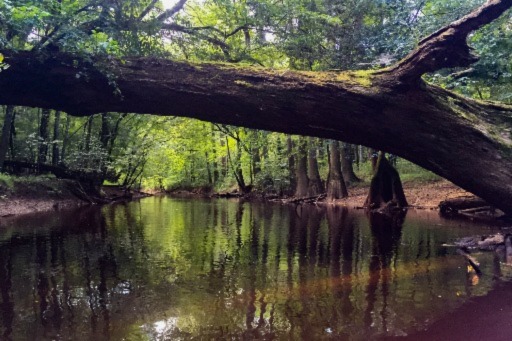
NPS / Victoria Stauffenberg
Cost: no entry fee
Established: 11/10/2003
Known for: Giant hardwoods and enormous pine trees
Things to do at Congaree National Park
- Hiking There are over 25 miles of hiking trails at Congaree National Park, ranging from easy to strenuous. The park is home to a variety of plant and animal life, so there is always something new to see on a hike. Hiking is a great way to get some exercise and fresh air while enjoying the beauty of nature.
- Canoeing The Congaree River runs through the national park and is a great place to go canoeing or kayaking. There are several outfitters located near the park that offer canoe and kayak rentals. Canoeing or kayaking is a great way to relax and enjoy the scenery.
- Join a ranger led program. These can be a lot of fun! Two of the offerings at Congaree are Owl Prowl and the Big Tree Walk
Best Time to Visit
The best time to visit Congaree National Park is in the spring or fall. The park is located in South Carolina, which has a humid subtropical climate. This means that the summers are hot and humid, while the winters are mild. Spring and fall offer the perfect balance of temperatures, with highs in the 60s and 70s and lows in the 50s.
Where to Stay Nearby
You can tent camp inside the park with reservations.
Nearby cities with ample lodging include Columbia and Lexington
Acadia
Visiting Acadia National Park is a truly unforgettable experience. The park’s stunning scenery, varied wildlife, and great recreational opportunities make it a must-see for any nature enthusiast. From the majestic summit of Cadillac Mountain to the lush forests of Acadia’s inland region, there is something for everyone in this beautiful national park. Whether you’re looking for an adventure like kayaking around Jordan Pond or a leisurely stroll along the famous Ocean Path Trail, you are sure to have a memorable time exploring Acadia’s breathtaking landscapes. Be sure to take in some of the historical landmarks like Thunder Hole and Sand Beach while you’re there too!
For those who love wide open spaces, Acadia has over 100 miles of hiking trails through its rolling forests and rugged coastline so you can explore as much as you’d like. When it comes to wildlife spotting, the park is home to over 200 species of birds, not to mention moose, black bears, foxes, and more! No matter what your interests may be – from bird watching to biking – Acadia National Park has something for everyone.
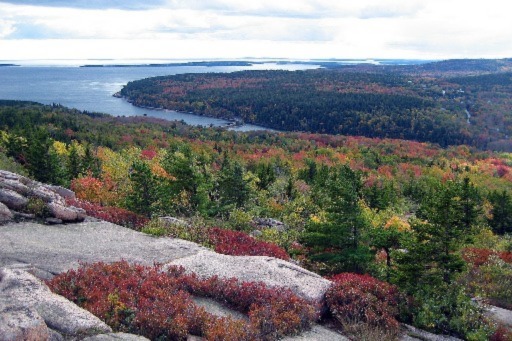
Cost:
Private vehicle= $30
Motorcycle=$25
Per person (no vehicle, walk in, bike in etc.) =$15 per person, aged 15 and under is free
Established: 02/26/1919
Known for: Incredible fall foliage. This is what makes Acadia one of the best national parks on the east coast. There’s nothing quite like the fiery colors bursting from every corner of the park.
Things to do at Acadia
- See the puffins ( June and July are the best months!)
- Tour the park on Park Loop Road
- Check out Jordan Pond
- Catch the sunrise at Bass Harbor Head Lighthouse
Best Time to Visit
- For less crowds and decent weather, go in April/May
- For fall color, September-Mid October
- To see the puffins, June or July
Tips for Visiting:
- Visit During Off-Peak Season 4 million people visit Acadia each year. In 2021, June through October saw over half a million visitors each month. If you want to avoid crowds, go during the off season.
- Get an Early Start Another way to avoid the crowds is to get an early start on your day. Many of the popular trails and attractions at Acadia National Park can get quite crowded later in the day, so if you want to beat the crowds, make sure to get an early start.
- Bring Your Own Food At least snacks. Acadia National Park is a large park with many different activities to keep you busy, but there are not many food options available inside the park boundaries. There are a few restaurants near some of the popular attractions, but they can be expensive and may not have the type of food you’re looking for.
Where to Stay Nearby
Bar Harbor, Maine is the place to be. You’ll find this town right outside the park. You’ll find many hotels, motels, and bed and breakfasts.
For a fun, different experience, check out Acadia Wilderness Yurt Village for your trip.
Everglades
Visiting Everglades National Park is an unforgettable experience. Located in Florida, it is the largest subtropical wilderness in the United States and is home to many rare animal and plant species. There are plenty of activities to do while visiting the park, such as taking a leisurely airboat ride through the grassy marshes, paddling a canoe through the mangroves, or going on a guided hike to view some of the endangered species like the American crocodile or West Indian manatee. Visitors may also take part in ranger-led programs, bird watching tours and ecological boat tours that educate visitors about how these animals converge on this unique habitat.
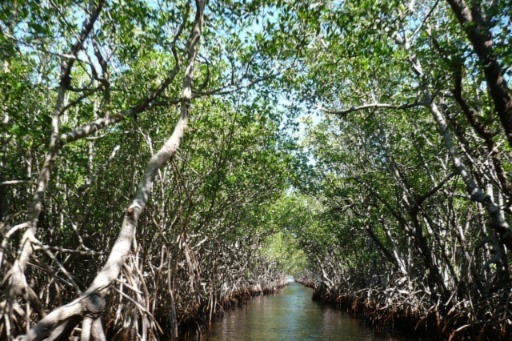
Cost:
Vehicle = $30
Motorcycle =$25
Walk/bike/paddle =$15
Established: 12/06/1947
Known for: Mangrove forests and sawgrass prairie, and less formally, ‘gators.
Mangroves are a type of wetland tree found in the coastal regions of Florida and other areas around the world. They provide a unique habitat for many species of animal and plant life, as well as protecting coastlines from erosion and extreme weather. The Florida mangroves are particularly fascinating due to their size, with some trees reaching over 80 feet in height and having root systems that can span up to 165 feet across. Their trunks may reach up to 12 feet in diameter, making them an impressive sight.
Things to do at Everglades National Park
- Visit Shark Valley for great wildlife viewing opportunity
- Wrestle an alligator
- Kayak or canoe the 99-mile Wilderness Waterway
- Go Slogging (wet hiking) to see elusive wildlife up close
- Check out some ranger led programs, including hikes, tours, campfires, and more
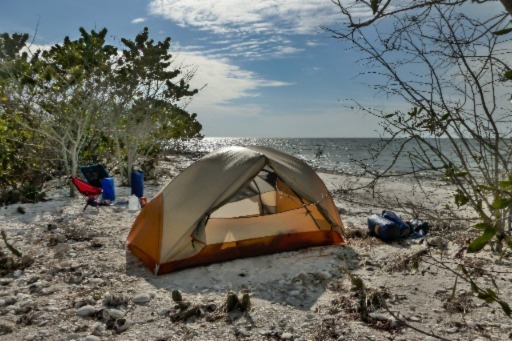
NPS / Jane Gamble
Tips for Visiting
- Pack for the Heat and Humidity The Everglades is a subtropical environment, so it’s important to pack for the heat and humidity. Be sure to pack light, loose-fitting clothing, sunscreen, insect repellent, and plenty of water. It’s also a good idea to wear closed-toe shoes to protect your feet from the sun and insects.
- Explore the Park by Boat One of the best ways to explore the Everglades is by boat. There are many different tour companies that offer boat tours of the park, so be sure to do some research in advance. You can also rent a canoe or kayak if you’re feeling adventurous.
- Watch for Alligators Alligators are one of the most iconic animals of the Everglades, so it’s only natural that you’ll want to see them during your visit. However, it’s important to remember that they are wild animals and can be dangerous. Never approach an alligator unless you are with a qualified guide and always give them plenty of space.
Where to Stay Nearby
Florida City and Homestead, FL are two of the closest cities to this remote park.
Everglades Chickee Cottages – Ochopee
Biscayne
Biscayne National Park is located in south Florida, just off the coast of Miami. It is home to an array of aquatic and terrestrial habitats including mangrove forests, coral reefs, seagrass beds, and maritime hammocks. This park provides a refuge for many species of birds, fish, sea turtles, and marine mammals such as manatees. Biscayne National Park spans 172,971 acres and features five different ecosystems: coastal mangroves, shallow waters, coral reefs, open ocean hardbottom communities, and transitional/terrestrial communities.
The park also offers visitors a variety of recreational activities including camping, snorkeling and scuba diving with over 11 miles of boat trails to explore the untouched backcountry. Visitors can also enjoy guided tours that focus on the history and ecology of the area as well as the barrier islands surrounding it. With its unique combination of rare ecosystems and diverse wildlife habitats, Biscayne National Park provides visitors with unparalleled opportunities to experience nature up close in this beautiful environment.
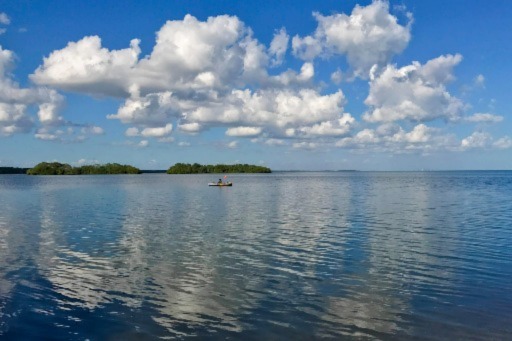
Cost: No entrance fee
Established: 09/28/1980
Known for: Being a top scuba diving location, world’s third-longest living coral reef, being over 90% water
Its amazing scuba and snorkel opportunities makes it one of the best national parks on the east coast!
Things to do at Biscayne National Park
- Snorkel the Mandalay shipwreck
- Scuba dive or snorkel the Maritime Heritage Trail
- Camp on one of the islands
- Take a guided boat tour

Best Time to Visit
There is no bad time to visit. The temperatures stay pretty steady year-round, with the lowest lows (60ish degrees Fahrenheit) in January. May through September has the highest precipitation. June through October is considered hurricane season.
Tips for Visiting
- Check the weather before you go Biscayne National Park is located in southern Florida, which means that it can be quite hot and humid during the summer months. If you plan on visiting the park during the summer, be sure to pack plenty of sunscreen and water. The winter months can also be quite cool, so be sure to pack a jacket if you plan on visiting during this time of year.
- Pack a lunch There are several picnic areas located throughout Biscayne National Park, so be sure to pack a lunch if you plan on spending the day exploring the park. There are also several restaurants located near the park if you prefer not to pack your own lunch.
- Bring towels, extra clothes, and water shoes 90% of the park is water, so chances are high you’ll be exploring where it’s wet!
Where to Stay Nearby
There aren’t any places to stay inside the park, unless you’re going to camp on one of the islands. To find a hotel or other lodging, Homestead, FL and Florida City, FL are the nearest cities to the park.
Dry Tortugas
Dry Tortugas National Park is a truly unique and special place to explore. Located 70 miles west of Key West, Florida in the Gulf of Mexico, it consists of seven small islands that form an archipelago, along with the surrounding shallow waters. The area is known for its array of spectacular coral reefs, over 200 species of fish, and a variety of bird species like brown pelicans and frigate birds. Along with these incredible creatures, Dry Tortugas also boasts historical attractions such as Fort Jefferson, which has been declared a national monument by President Theodore Roosevelt in 1908.
Visitors can enjoy activities such as camping, snorkeling and diving at Loggerhead Reef, fishing or birdwatching in the crystal-clear waters surrounding the islands or visit Fort Jefferson’s museum showcasing artifacts from past military operations conducted here. With its remote location and pristine beauty, Dry Tortugas National Park provides an unforgettable experience unlike any other!
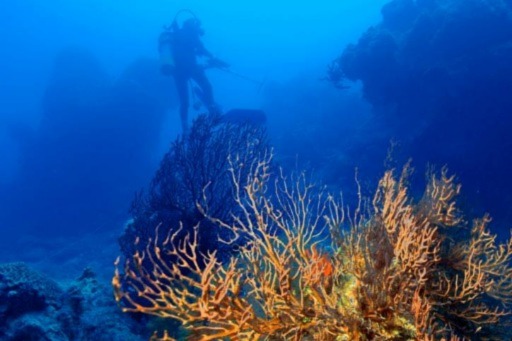
Cost: Entry is $15 per person. This fee only applies to those 16 and older.
Established: 01/04/1935
Known for: Having an amazing, undisturbed tropical ecosystem, including it’s coral reefs and marine life
Things to do at Dry Tortugas National Park
- Snorkel and scuba dive The waters around Dry Tortugas National Park are teeming with marine life, making it a popular spot for snorkeling and scuba diving. There are several shipwrecks in the area that are perfect for exploring, including the Windjammer, which was sunk in 1985 as an artificial reef. Visitors can also see a variety of fish, coral, and other marine life when they snorkel or dive in the waters around Dry Tortugas National Park.
- Explore Fort Jefferson Fort Jefferson is a 19th-century fort that was used as a prison during the Civil War. Today, the fort is open to visitors who want to explore its massive walls and learn about its history. Ranger-led tours of the fort are offered daily, and visitors can also explore the fort on their own.
- Take a ferry from Key West Dry Tortugas National Park is located about 70 miles from Key West, Florida. The only way to reach the park is by boat or seaplane. The most popular way to get to the park is by taking the ferry from Key West. The ferry ride takes about 2.5 hours and provides stunning views of the turquoise waters of the Gulf of Mexico.
Best Time to Visit
- Summer is a beautiful time to visit the park, but be prepared for storms and mosquitos.
- January through June and November and December are the best months for comfortable weather
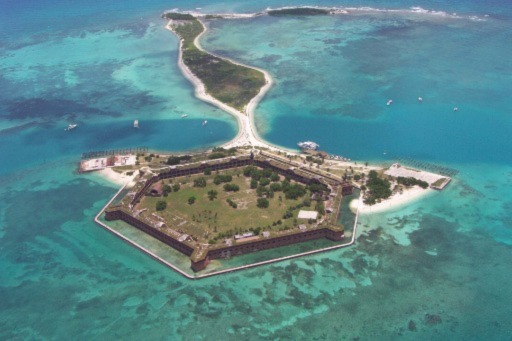
Tips for Visiting
- Plan Ahead If you’re planning to camp, you’ll need to book your reservations well ahead of time. A lot of bookings are made 8 to 12 months in advance
- Make a Reservation Dry Tortugas National Park is located in the Florida Keys and is only accessible by boat or seaplane. The park is extremely popular, so it’s important to make a reservation for your trip well in advance. You can make a reservation for a campsite, picnic area, or tour online at recreation.gov.
- Bring Your Own Food and Water There are no restaurants or stores located within Dry Tortugas National Park, so it’s important to bring enough food and water for your entire trip. It’s also a good idea to bring snacks and drinks for the boat or plane ride to and from the park.
- Swim and Snorkel Dry Tortugas National Park is home to some of the best snorkeling and swimming in the Florida Keys. The clear waters around the park are teeming with fish, coral, and other marine life. Be sure to bring your swimsuit and snorkeling gear so you can enjoy the beautiful underwater world of Dry Tortugas National Park!
Where to Stay Nearby
There is no where to stay inside the park, but Key West is the closest city.
National Parks in the East
Indiana Dunes
Indiana Dunes National Park is located on the shores of Lake Michigan and is a 15,000 acre oasis of natural beauty. This park features a variety of landscapes including vast dunes, woodlands, wetlands, marshes and diverse wildlife habitats. From bird watching to hiking and swimming to fishing, Indiana Dunes National Park has something for everyone! Home to many rare plants and animals, this diverse landscape offers spectacular views of Lake Michigan’s shoreline and rolling sand dunes. In addition to its breathtaking scenery, the park boasts an abundance of outdoor activities such as biking trails, camping sites, nature centers and beaches perfect for picnics or swimming in the summer months.

Cost:
$25 per passenger vehicle, $20 per motorcycle (7 day pass)
$25 per pedestrian/bicyclist/boater good for 7 days (15 and under do NOT have to pay a fee)
An Indiana Dunes Annual Pass is $45
Established: In 1966 it was established as a national lakeshore, but on February 15, 2019 it upgraded it’s status to a national park
Known for: diverse plant life
Things to do at Indiana Dunes National Park
- Hike the dunes. Try the Diana of the Dunes Dare
- Visit one of the beaches
- Hike Cowles Bog Trail and check out the diverse scenery along the way
Best Time to Visit
Summer is very busy and crowded, especially after the park gaining it’s new status. If you’re wanting to visit the beaches, this is a great season for that, with the cool lake waters nearby to escape the heat.
If you’re wanting to explore more freely, visit a not so crowded beach, or photograph any of the beautiful scenery, spring or fall will be less crowded with cooler more comfortable temps.
Tips for Visiting
- The parking lots fill up fast. Get there early.
- Take comfortable sandals for hiking or climbing on the dunes, or gaiters to keep the sand out of regular shoes.
Where to Stay Nearby
With the park spanning 15 miles of the lake, there are many nearby cities to choose from.
- My personal favorite, Valparaiso, Indiana, is a vibrant city located in the Northwest corner of Indiana. It is known for its historic charm, welcoming atmosphere and lively university life. Boasting beautiful architecture and plenty of cultural attractions, Valparaiso has something for everyone including a variety of outdoor activities. The downtown area is notable for its unique collection of small businesses and restaurants, featuring local craft brews and authentic cuisine.
- Portage, Chesterton, and LaPorte are all nearby and provide hotel options and easy access to the park
Pictured Rocks
Pictured Rocks National Lakeshore is an amazing destination in Michigan’s Upper Peninsula. Located along the shores of Lake Superior, this beautiful park offers a variety of recreational opportunities including camping, kayaking, and hiking. The picturesque landscape features dramatic sandstone cliffs, streams and waterfalls, massive sand dunes, and dense forests. Visitors are able to explore a wide array of scenic lakes, rivers and coves throughout the park. Pictured Rocks National Lakeshore is home to over 700 species of plants and animals which make it one of the most biodiverse parks in North America.

Cost: These are the updated costs that take effect January 1, 2023.
- 7 day vehicle pass= $20
- 7 day motorcycle pass= $15
- 7 day pedestrian, bicycle, boat in, or snowmobile= $10
- 12 month Annual pass= $30
Established: 10/15/1966
Known for: In addition to its amazing natural beauty and abundance of wildlife, Pictured Rocks is also known for its fascinating geologic history. This area was formed over 13 000 years ago when the last glacial ice sheet melted away leaving behind distinctive rock formations made up of multicolored mineral deposits.
Things to do at Pictured Rocks National Park
From admiring stunning sunsets on Lake Superior’s shoreline or simply marveling at the breathtaking views along its trails – Pictured Rocks National Lakeshore provides visitors with an opportunity to experience nature in all its glory!
There is so much beautiful scenery that can only be seen from the water. I highly recommend some kind of water tour.
- Kayak! There are numerous tour companies in the area to take you on guided kayak tours.
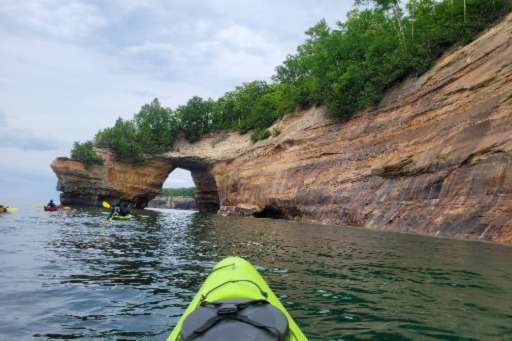
- Sunken ship boat tour on a glass bottomed boat
- Hike a section of the North Country Trail
- Go on a waterfall hunt
- Attend a ranger program to learn about the park or the animals found there.
- Kids can even become a junior ranger and earn a ranger badge for completing activities in a booklet.
Best Time to Visit There really is no bad time to visit. There are, however, better times to visit depending on what you’d like to do and see.
If it’s waterfalls you’re after, spring will provide the rainfall to produce the best falls.
If it’s kayaking or other water/boating activities, summer and early fall should be your top seasonal choices.
Fall color more your thing? The leaves turn pretty early way up north, usually starting their change in September and peaking in mid-October.
Winter visits provide opportunity for ice fishing, visiting the ice caves, snowshoeing, and ice climbing. Be aware that even though the park is open year-round, some of the roads in the park or to the park may be closed due to heavy snowfall or dangerous road conditions.
Tips for Visiting Pictured Rocks
- Check the Weather
Before heading out to Pictured Rocks National Lakeshore, be sure to check the weather forecast. The weather can change quickly in Michigan, and you don’t want to get caught in a storm. If possible, plan your visit for a sunny day.
- Bring insect repellent
Mosquitoes can be a problem in Michigan, so be sure to pack insect repellent. Apply it liberally, especially if you’ll be spending time near water, or risk getting carried away by the pesky buggers.
- Pack Plenty of Water
There aren’t always places to fill up or get a drink, so be sure to bring plenty of water with you. At least one gallon per person is recommended.
- Don’t Forget Your Camera!
Pictured Rocks National Lakeshore is one of the most beautiful places in Michigan, so don’t forget your camera! Be sure to snap plenty of photos to remember your visit.
Where to Stay Nearby
You’ll likely be staying in Munising or Grand Marais, they’re the two biggest towns near the park.
- North Star Hotel Pictured Rocks I can’t recommend this place enough. We had the pleasure of staying at this hotel during our first visit to Pictured Rocks, and it couldn’t have been a more pleasant experience. The hotel was spotless and well-maintained, and it’s convenient location near the park made it easy to access both the natural beauty of Pictured Rocks and the local restaurants, shops, and attractions.
But what really made our stay exceptional were the staff members at the front desk; they were absolutely amazing! They were so friendly and helpful, always willing to answer any questions we had about our stay or the surrounding area. They went out of their way to provide us with all sorts of information about nearby tourist spots, hiking trails, great places to eat, and other exciting activities in town.
- Pictured Rocks Bed and Breakfast in Munising. Waterfalls within walking distance, panoramic views, and a wraparound deck to enjoy the views from outside.
- You’ll also have your “find them everywhere” hotels, including your Comfort Inns, EconoLodge’s, and Wyndham hotels, and a variety of motels in Munising and Grand Marais.
Mammoth Cave
Mammoth Cave National Park is a unique geological wonder located in the state of Kentucky. Since its discovery in 1809, it has been known to be the world’s longest cave system, boasting over 400 miles of surveyed passageways and more than 200 underground chambers. It is one of the oldest tourist attractions in the United States, with visitors coming to explore its mysterious depths and discover its hidden beauty each year.
Mammoth Cave offers a range of activities for visitors, such as exploring its vast cave system by taking ranger-led tours of different sections or going on wild cave adventure trips through deeper areas. There are also plenty of educational opportunities available at the park, such as attending lectures, participating in cave biology programs or learning about Native American history and culture related to the area. With its rich cultural and natural history, Mammoth Cave National Park is an incredible place to visit that will leave you with a lasting impression!

Cost: Entry to the park is free. There is a fee to explore the caves, however. You must purchase a tour ticket to be able to enter the caves. Here’s the park page for tour booking and information.
Established: 07/01/1941
Known for being the world’s longest cave system
Things to do at Mammoth Caves
- Do the “Beneath Your Feet” program. This is fun for families with kids.
- Stargaze on your own or join a Night Sky program led by a park ranger.
- Kids can become a Junior Ranger Night Explorer.
- Kayak the river
Best Time to Visit
Again, there’s no bad time to visit this park. The temps in the caves stay the same year-round (54 degrees Fahrenheit), but the outside temps vary depending on the season.
- For no crowds and open tour options, go December through February. The downside to this season is colder outside temperatures.
Tips for Visiting
- Get There Early
Mammoth Cave National Park is one of the most popular tourist destinations in Kentucky, and for good reason. The cave is the largest in the world, and it’s home to a variety of unique geological formations. However, because it’s such a popular destination, it can get pretty crowded, especially during the summer months. To avoid the crowds, plan to arrive at the park early in the morning.
- Bring a Flashlight
Even though Mammoth Cave is lit up with electric lights, it’s still a good idea to bring your own flashlight. This way, you’ll be able to see any cool formations that might be off the beaten path. Plus, if there’s a power outage (which does happen from time to time), you’ll still be able to see your way around.
- Wear Comfortable Shoes
Mammoth Cave is huge, and you’re going to do a lot of walking. So, it’s important to wear comfortable shoes that you can walk in for hours without getting sore feet. Avoid wearing sandals or open-toed shoes, as you might stub your toe on a rock or step on something sharp.
- Bring a Jacket
Even though Mammoth Cave is underground and therefore pretty temperature controlled, it can still get chilly inside. So, be sure to bring along a jacket or sweater, just in case.
Where to Stay Nearby
- The lodge at Mammoth Caves is inside the park itself
- Cave City nearby has a variety of hotel options
Great Smoky Mountains
It’s easy to see why this makes the list of best national parks on the east coast! Great Smoky Mountains National Park is an incredible natural paradise situated in the Appalachian Mountains of East Tennessee. It is known for its beautiful and diverse landscapes, which include lush forests, stunning meadows, cascading waterfalls and towering mountains. The park is a popular destination for hikers, campers and outdoor enthusiasts alike due to its endless recreational opportunities including hiking trails, camping sites, fishing spots and canoeing areas.
The park also offers a wide range of educational activities such as ranger-led programs and cultural exhibits that teach visitors about the region’s unique history and ecology. In addition to these attractions, Smoky Mountain National Park boasts some of the most majestic views in all of Appalachia. From its highest peak – Mount LeConte – visitors can experience panoramic views of the surrounding mountain ranges which are blanketed with dense forest cover. No matter what time of year visitors come to explore Smoky Mountain National Park they will be in awe at its breathtaking scenery and boundless adventures waiting to be discovered!
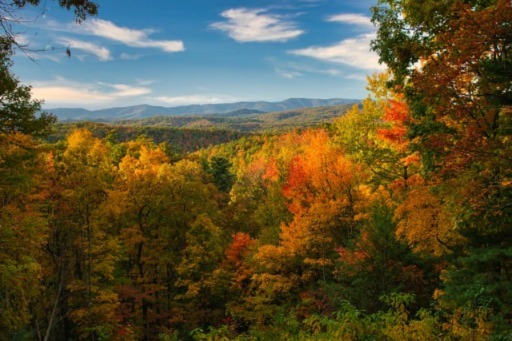
Cost: Free entry. You will need a parking pass if you plan to park anywhere within park boundaries for longer than 15 minutes at a time. the passes are $5 daily, $15 weekly, or $40 annually
Established: 06/15/1934
Known for: its diverse wildlife, majestic mountains, and beautiful views
Things to do at Great Smoky Mountains
- Check out Cades Cove by car. This area is diverse with wildlife, including the black bears that many visitors want a glimpse of.
- Traverse Clingman’s Dome to see panoramic views that will leave you breathless
- Hike a section of the Appalachian Trail
Best Time to Visit
All year is absolutely amazing, I can’t pick a season to say is the best. There’s amazing color in the fall, comfortable winter temps (compared to the Midwest at least), waterfalls in the spring, and many ways to keep cool on hot summer days.
Tips for Visiting
- Check the weather before you go The Great Smoky Mountains National Park is located in a very mountainous region, which means that the weather can change very quickly. Be sure to check the forecast before you visit so that you can be prepared for any potential inclement weather.
- Bring a camera There are many beautiful views located within the park, so be sure to bring a camera so that you can capture some memories of your visit.
- Leave no trace The Great Smoky Mountains National Park is a very popular tourist destination, which means that it is important to be respectful of the environment. Be sure to practice Leave No Trace principles such as packing out all of your trash and being mindful of where you hike so as not to damage vegetation.
Where to Stay Nearby
Gatlinburg and Pigeon Forge are the most popular options. You can find hotels or rent cabins. Sevierville is another popular nearby city.
New River Gorge
The New River Gorge is an amazing natural landmark located in the Appalachian Mountains of southeastern West Virginia. Spanning over 3,000 feet in width and 800 feet in depth, it is one of the oldest rivers in North America and is a part of the National Park Service. It offers breathtaking views of the surrounding valleys, steep cliffs, and rolling hills. There are plenty of outdoor activities to enjoy while visiting this unique area such as hiking trails through lush forests, kayaking down its thrilling rapids or fishing from its calm waters. Visitors can take advantage of many educational opportunities as well along its network of interpretive trails with information about the history and ecology of this special place. With its breathtaking views and abundance of recreational activities, New River Gorge provides an unforgettable experience for all who visit this east coast national park!
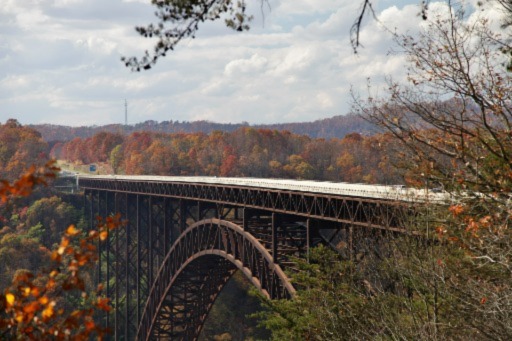
Cost: No entry fee
Established: 11/10/1978
Known for:
It’s steel arch bridge, which until 2003 was the longest in the entire world. It’s also known for its expansive views.
Things to do at New River Gorge
- Rock Climbing The New River Gorge is one of the best rock climbing destinations in the United States. There are over 1,500 routes of varying difficulty, so there is something for everyone. The park also offers several climbing clinics and guided tours for those who want to learn more about the sport.
- Whitewater Rafting Whitewater rafting is another popular activity at the New River Gorge. The park offers several different whitewater rafting trips, ranging from calm floats down the river to more adventurous Class III and IV rapids. No matter what your skill level, there is a trip that is perfect for you
Best Time to Visit
April through October are by far the best times to visit. Summer has the largest crowds, but the rest of the months aren’t crazy packed. For fall colors, you’ll want to go end of September through October. For whitewater rafting, head there anytime during those months.
Shenendoah
Shenandoah National Park is a stunningly beautiful mountain escape located in the Blue Ridge Mountains of Virginia. Spectacular views from its panoramic overlooks, hundreds of miles of trails, cascading waterfalls and lush, green forests provide visitors with an unforgettable experience. This 200,000-acre park offers something for everyone – including camping, fishing, biking and horseback riding – as well as plenty to learn about its history and rich biodiversity. The park is home to over 85 species of mammals and more than 200 species of birds, while rare plant species such as wild orchids can be found growing along the trails. The famous Skyline Drive traverses the entire length of the park and provides spectacular views along the way; making it one of the most scenic drives in America. Exploring this incredible natural area is sure to be a memorable experience that will last a lifetime!
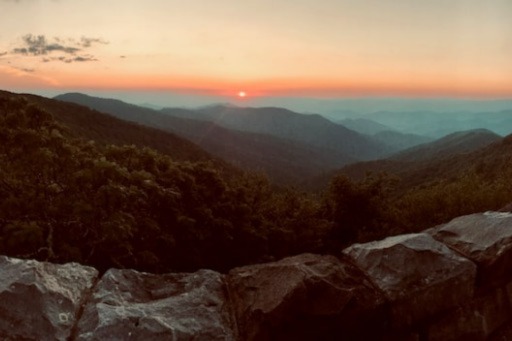
Cost:
Established: 12/26/1935
Known for Skyline Drive: A breathtakingly beautiful 105-mile stretch that winds through the Shenendoah National Park. It’s one of the few public scenic byways in the US, and becoming increasingly popular . Along Skyline Drive, you can take in some stunning panoramic views of the Blue Ridge Mountains as you travel along its winding paths. The drive passes through four distinct ecological zones, each offering a unique experience for visitors.
Things to do at Shenendoah
- Skyline Drive is an absolute must do.
- Hike Some of the most popular trails in the park include Old Rag Mountain, Dark Hollow Falls, and White Oak Canyon.
- Camping Shenendoah National Park offers over 200 campsites that are available on a first-come, first-served basis. Campsites can be found throughout the park, and many offer stunning views of the surrounding mountains. Sites for this east coast national park can fill fast for popular weekends, so be sure to book early!
Best Time to Visit September to November and March to May re considered the prettiest times. But summer brings the dark, lush greens that forest lover’s dream of.
Tips for Visiting
- Don’t Miss the Sunrise One of the best times to visit Shenandoah National Park is at sunrise. The park is located in the Appalachian Mountains, which means you’ll be able to see some stunning views as the sun rises over the mountains. Be sure to get there early so you can find a good spot to watch the sunrise.
- Bring Plenty of Water Shenendoah National Park is a large park with plenty of opportunities for hiking and other activities. Make sure to bring plenty of water with you to stay hydrated during your visit. It is also a good idea to bring snacks and lunch, as there are not many places to buy food inside the park.
Best National Parks on the East Coast
- Acadia: Best National Park on the East Coast for Fall Color and Seascapes
- Biscayne: Best East Coast National Park for Snorkeling and Diving
- Pictured Rocks: Best East Coast Park for Kayaking
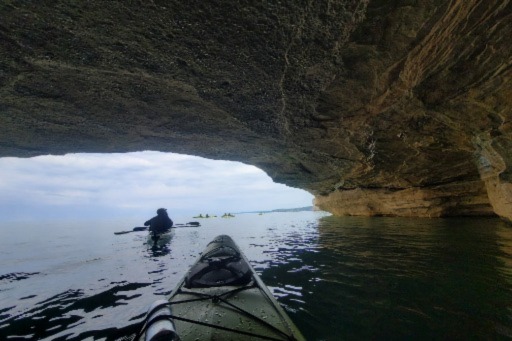
- Great Smoky Mountains National Park: Best for Mountain Views
- Shenendoah: Best for Backpacking